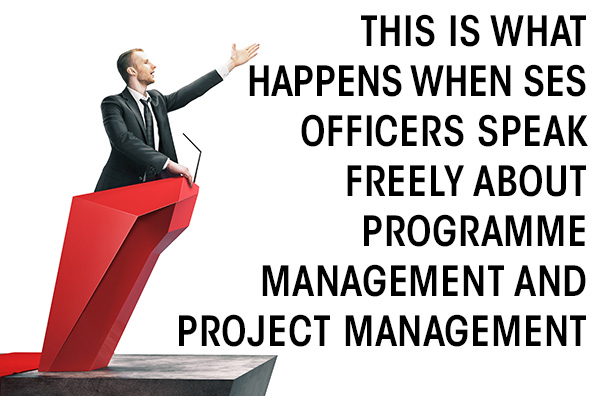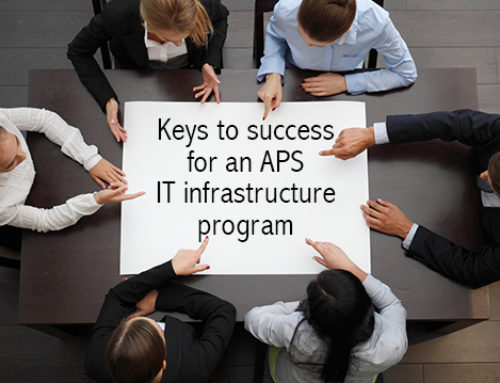In my last blog I wrote about the one simple thing most SES officers get wrong with programmes and projects: they don’t think about programmes and projects as organisations.
This observation generated quite a lot of interest, and so this month I’d thought I’d share with you what happens when SES officers are given the opportunity to speak freely about programme management or project management.
“SES officers speak freely? Yeah right! Like that’ll ever happen…”
If that was your reaction, and you wouldn’t be the first person I have known to react that way, then I would invite you to (re)open your mind. Senior executives are humans like the rest of us, and they have thoughts and feelings that are not necessarily evident simply from observing what they say and what they do. If you have the capacity to develop trust, respect and rapport with your SES, you are far more likely to have an effective engagement with them where they say what’s on their mind.
Assuming the pre-requisites are in place for an authentic conversation to occur, let’s examine what happens when the door closes and the conversation begins.
How do you start an executive conversation about programme/project management?
“Hello, my name is John and I’m here to tell you all about PRINCE2. It has seven principles, seven themes and seven processes. I’m going to explain all those to you and we’ll look at the templates as well.” That is about the worst possible opening line I can imagine. It might be somewhat exaggerated, but it is painfully close to some of the internal presentations I have witnessed. What is the single most common flaw? Launching into an explanation of {insert PPM topic of your choice here} without first establishing any context or ascertaining what those present want to get out of the discussion.
What is the right way to start the conversation? Assuming you have dealt with “meeting hygiene” factors such as how long the discussion will take, introductions etc, how about inviting each participant to briefly address:
- What brought them to this conversation;
- What programme/project management means to them;
- What experience they have in programme/project management
- Topics they’d like to cover in the discussion; and
- What they want to take away from the discussion.
If you have limited time, a killer question which I picked up from an executive coach years ago, and still use to this day, is: “what would make this conversation most useful for you?”
The things SES officers are usually seeking
Context. It is no use launching into the specifics of MSP, PRINCE2, P3M3, your framework, why benefits management is important etc etc, if you have first established where the discussion fits into their world. For example, most SES discussions touch upon the concept of “run the business versus change the business” very early on.
Purpose. Before explaining the “what” of programme management or project management, you need to understand the “why”. Did you notice I didn’t say explain the why? Your job is to understand why the topic at hand is relevant and useful to the executive(s) you are speaking with. This requires you to have a practical understanding of their role and their challenges, so you can correctly position your PPM topic as a means to assist. If you can confidently identify with and articulate the problems they have, and explain why programme management or project management can help address those problems, you have a firm foundation for a productive conversation.
Mental Model. SES officers are busy people, they have to cover a vast array of topics under great time pressures. Most likely they don’t have the time or inclination to absorb the detail, so you won’t be thanks for droning on about detailed terminology definitions and nuances for hours on end. They are seeking a simple mental model that allows them to relate the disciplines you are inimitably familiar with to the context and challenges they face.
Practicalities, Problems and Perceptions. Theory is fine, but you need to know how to make these things work in practice, and how to address known problems and perceptions. Some examples:
- We don’t have time for this;
- We have enough templates to sink a ship and they don’t add any value;
- Qualifications don’t prove anything;
- This is important but my staff can handle it on my behalf;
- Our superiors have said we’re not going to have one of those; and the timeless classic…
- We don’t do it like that here.
What happens
If you start the conversation effectively, understand what is being sought, and know your PPM back-to-front, then in my experience what happens is a very powerful conversation. Lightbulb moments. Ah ha moments. Engagement. Understanding. Excitement even.
It is hardly ever about the detail. It is virtually always about the fundamentals, for example:
- Using a role-based temporary decision-making structure that cuts across organisational boundaries.
- Effectively engaging people from the real business areas.
- How to avoid death-by-template.
- Making benefits and products real.
I could go on, but I’ll stop there, and save the rest for future blogs.
Want to know more?
If you would like to know more about engaging SES about programme management or project management, please call me personally on 0407 404 688 or email me at john.howarth@tannerjames.com.au. I would be very happy to come to meet you, answer questions and provide further information.
What do you think?
Please feel free to comment on the blog itself or via LinkedIn.






Leave A Comment